By Rev. Heng Sure
A REVIEW OF THE COMING INTERSPIRITUAL AGE

Count me a team-member of the interspiritual movement. I am in sympathy with the goals of The Coming Interspiritual Age by Kurt Johnson and David Robert Ord, a grand, ambitious work with an optimistic vision of future global unity. Kurt Johnson’s mental scope on display here is astonishing. A polymath, he was for thirty years a distinguished scientist at the Museum of Natural History, penned an award-winning New York Times best seller about Vladimir Nabokov and butterflies, and regularly contributes to Wikipedia, all attesting to the breadth of his discussion of how humanity came to its current crises of religious conflict and spiritual dis-ease. Johnson and Ord’s ability to weave facts into sweeping historical narrative lends strength to their conclusions.
The authors pull together compelling evidence of a coming spiritual convergence from a number of diverse fields of knowledge: from history and biology to personal mystical experiences of unity. As evidence of evolving awareness, they survey current political events such as 9/11, Arab Spring, and the Occupy movement. They hint at a potential Roman Catholic Spring, winning them few friends, I fear, among the Catholic hierarchy.
They prescribe “interspirituality,” a term coined by the late Br. Wayne Teasdale. In The Mystic Heart: Discovering a Universal Spirituality in the World's Religions, Teasdale envisions interspirituality as the medicine for our current planetary, social, political and personal malaise. Those of us committed to interfaith/interreligious sharing, respect, and healing can contribute a heart-felt “amen” to support this sentiment.
Brother Wayne was known as a light-hearted, down-to-earth soul, even a jokester, who never took himself too seriously. But his vision of finding common ground ‘in the spirit’ for people whose religions were in discord lead him beyond the boundaries of traditional religious forms and beliefs. His interfaith engagement included being a founder of the Monastic Interreligious Dialogue (DIM/MID). It is an organization of Benedictine and Trappist monks and nuns committed to fostering interreligious and inter-monastic dialogue at the level of spiritual practice and experience between North American Catholic monastic women and men and contemplative practitioners of diverse religious traditions.
Taking the East More Seriously
The Coming Interspiritual Age contains gems of insight in its analysis of the issues troubling the secular world; one wants to linger and reread passages from page to page. Writing, though, from the perspective of an American Buddhist monk, I want to point out some missing planks on the bridge we are building across the Pacific between theistic religions and Buddhism, a non-theistic religion. This book rehearses the same platitudes about “mystical Eastern traditions” that have marked Euro-American scholars of Eastern religion since we first “discovered” Asian religious traditions in the nineteenth century.
One would hope for more precision in the citation of Buddhism. For example, sunyata, or emptiness, should not be labeled “the divine nature.” To conflate a list of dissimilar Buddhist technical terms in Pali, Sanskrit, Japanese and English terms (samadhi, nibbana, satori, kensho, prajna, nirvana, Buddhahood, realization of the self) and equate them all with the “unity nature” is simply inaccurate. Making them the equivalent of the “unity nature” further muddies the water. In my laundry list for advances in presenting Buddhism I would hope for acknowledgement of the Mahayana, or Northern Tradition, with its vast scriptures describing the Bodhisattvas.
As much as I encourage the search for universal spiritual principles upon which to establish a global culture of peace and harmony, roughly forcing very different realities into the mold of “oneness” hinders rather than helps the enterprise. Surely the book’s earnest purport, global transformation of our species to promote interspirituality as the means to keep human civilization from destruction, is commendable; a lot is at stake in promoting this vision.
But to wave in the direction of “the East,” as the authors often do, citing Hinduism, Buddhism and Taoism as sharing common spiritual roots, is a truism. Those roots bear very different fruit. Precisely because interfaith has made us good neighbors across religious boundaries, we can begin to recognize the genuine differences between religions without getting nervous and needing to make them all One.
At the end of the path, Sunyata is not a synonym for God or the divine nature. Hindus seek moksha and merging with the godhead into Brahman; the Buddha’s nirvana is not that. Certainly no Hindu affirms Nirvana; no Buddhist affirms God’s love. Satori, samadhi and prajna wisdom are not Buddhahood, and “unity consciousness” does not gain adherents by carelessly equating these terms.
“Buddhist mystics” is an oxymoron from the point of view of the Chan/Zen school. The Bodhisattva, the Awakened Being of the Mahayana School of Buddhism, takes as his or her task the gradual purification and concentration of the human mind. This work of cultivation is not mystical. It is, rather, as laborious and deliberate as cleaning rocks from a garden or adding tilth to clay to make loam. The wish for oneness without the foundation of disciplined practice within each tradition is like trying to get full while reading the menu.
I can’t endorse this book as a Buddhist but can read it enthusiastically as a fan. I want this book to succeed, and I fear it will be dismissed as yet another mishmash of New Age, syncretistic confusion. It is much, much better than that and deserves our attention. Moving forward in our understanding of the heart of the religions of Asia will give us solid ground for interspiritual discovery. But in the rush here to “all is one,” you leave behind the solid ground you must push against in order to gain altitude.

